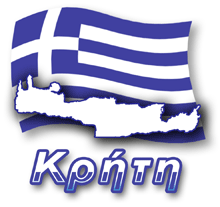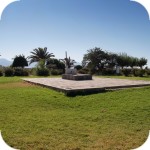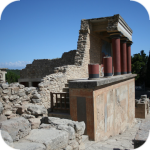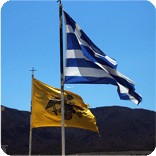
[read previous >> History of Crete from Paleolithic to Dark Ages]
(480 BC - 395 AD)
The growing importance of Athens causes a drastic reduction in the political and iconic role of Crete. In 67 BC, the island gets into the hands of the Romans, who are beginning to introduce their orders. Gortyna becomes the capital of the Roman province called Crete-Kyrene. The Romans are building infrastructure: roads, aqueducts, temples and theaters. Agriculture and culture are developing. All of Greece at this time becomes a Roman province, although its rich culture begins to influence the achievements of the Romans. In AD 59, an apostle Paul comes to the island, whose companion Titus is appointed the first bishop of Crete. The island stands at the beginning of the Christian era ...
(337-826 AD)
In 395, the Roman Empire is divided into the eastern and western parts, which in consequence determines the further affiliation of Crete, which has since then been part of the Byzantine Empire. The Byzantine Empire of Crete owes numerous churches and the impressive basilica of St. Titus in Gortyna, whose magnificent walls have survived to this day, where you can admire it. The rule of the Romans is interrupted in 826 AD by Arabians who invade the island.
(826-961 AD)
The invasion of the Arabs causes a new wave of unrest which is pushing the island. The new invaders destroy all early Christian buildings and persecute the Christian population. Crete is used by Arabians as a starting point for expeditions in the Aegean Sea. The island has a new fortified capital - Rabd el Chandak - present Heraklion.
(961-1204 AD)
In 961, the Byzantines are asking for Crete again and under the leadership of Nikeforos Fokas, they reflect the island. Crete returns to Christianity, followed by economic and cultural revival manifested in wall paintings and sacred architecture.
(1204-1669)
In the fourth crusade, the Crusaders conquered Constantinople, which led to the division of the Byzantine Empire between them. Crete came to the Count de Montferrat, who in the same year sold it to the Venetians. They tried to make Kreta look like a homeland in every respect. On the island, which along with its capital Chandak receives the name Kandia, economic and cultural growth is taking place. On the other hand, the local population, plagued by serfdom and taxes by powerful rulers, repeatedly tried to shake off the yoke many times during numerous uprisings. In 1453, Constantinople falls, from where artists and intellectuals flee to Crete. It contributes to the flourishing of art (above all sacred) and architecture, when magnificent churches, fountains, town halls and fortifications are built. The university in Kandy and the monastery school in Agia Ekaterini become loud. Their fame and reputation goes far beyond the boundaries of Crete. This period in the history of Crete is called the Cretan Renaissance.
(1669-1898)
The re-entry into the reign of the Turks, who captured the island after the 21-year siege, causes forced Islamization and huge taxes. This and the arbitrariness of the rulers cause the violent opposition of the Cretans, which again leads to bloody uprisings. In 1770, Greeks proclaim independence after one of them, which does not last long. The next year, the Turks regained control of the island. The Cretans are struggling to join Greece. The problem of Crete reaches the world public consciousness due to the tragedy that took place in Moni Arkadiou monastery. In November 1866, the Turks surrounded the monastery in the strength of 15 thousand. soldiers and 30 guns. A few hundred insurgents and about 700 women and children hid in the monastery. After a few days of siege, the Turks broke through the walls. Women and children who hid in the monastery's dustbin died in the air. In addition to 700 women and children, several hundred Turkish soldiers were killed. To this day the skulls of the fallen are exposed in the monastery, and the place itself is a place of national remembrance and independence for the Cretans. The event has had wide repercussions in Europe and the world and was of great importance for the independence of Crete in 1898.
(1898-1941)
In 1898, the Sultan's army left the island. A substitute of the parliament with Christian and Muslim deputies was created, and the function of High Commissioner of Crete was entrusted to the Greek Prince George I. Until 1913, the then Crete was divided into four zones of occupation by the powers of France, England, Italy and Russia. In 1908, the Republic of Crete declared independence not recognized however, internationally.
The demands of the Cretans for joining their island to Greece are fulfilled thanks to Eleftherios Venizelos, the Cretan Minister of Justice in the government of George I and the later prime minister of all Greece, when Crete was incorporated into Greece on 30 May 1913. Venizelos is also trying to extend the borders of the Greek state to Asia Minor, which ends with a defeat with Turkey (1919-1922). After the conclusion of the peace of Lausanne in 1923, the population was exchanged. Some of the Greeks from Asia Minor settle in Crete, and the island had to leave about 30 thousand Turks.
It is worth remembering that in that hot political period in 1900, British Sir Arthur Evans began excavation work in Knossos, where he quickly discovers traces of fallen Minoan civilization.
[read more >> Contemporary history of Crete]

Crete has always had a special place in the heart of Nikos Kazantsakis. Born on February 18, 1885 in Heraklion, thanks to the care of his parents, he came a long way to becoming one of the most important writers of contemporary Greek literature. Always faithful to his passions and beliefs, he rarely counted on the opinions of other people. In his life, he pointed to dreams and journeys as one of the greatest inspirations, which in 1957 contributed to the fact that the history of his life and work ended.

Description of the history of Crete. The genesis of the creation of culture, the most important events from the far and near past of this island. Until the middle of the first decade of the 21st century, little was known about the older Stone Age in Crete. Initial information was sporadic and uncertain. Only later discoveries made it possible to establish that the first inhabitants appeared on the southern coasts of the island already in the lower Paleolithic (about 130,000 years ago).

Early on the morning of October 28, 1940, at about 3 o'clock, just after the end of the sumptuous banquet that took place at the German embassy, Emanuele Grazzi went to the house of Joanis Metaksas. The Italian ambassador gave the Greek Prime Minister an ultimatum that contained a number of demands. Among them were the possibility of free passage of Italian troops to the Greek-Albanian border, control over airports, ports and other strategic places located on the territory of Greece.
Komentarze
Wypełnij poniższy formularz aby dodać komentarz